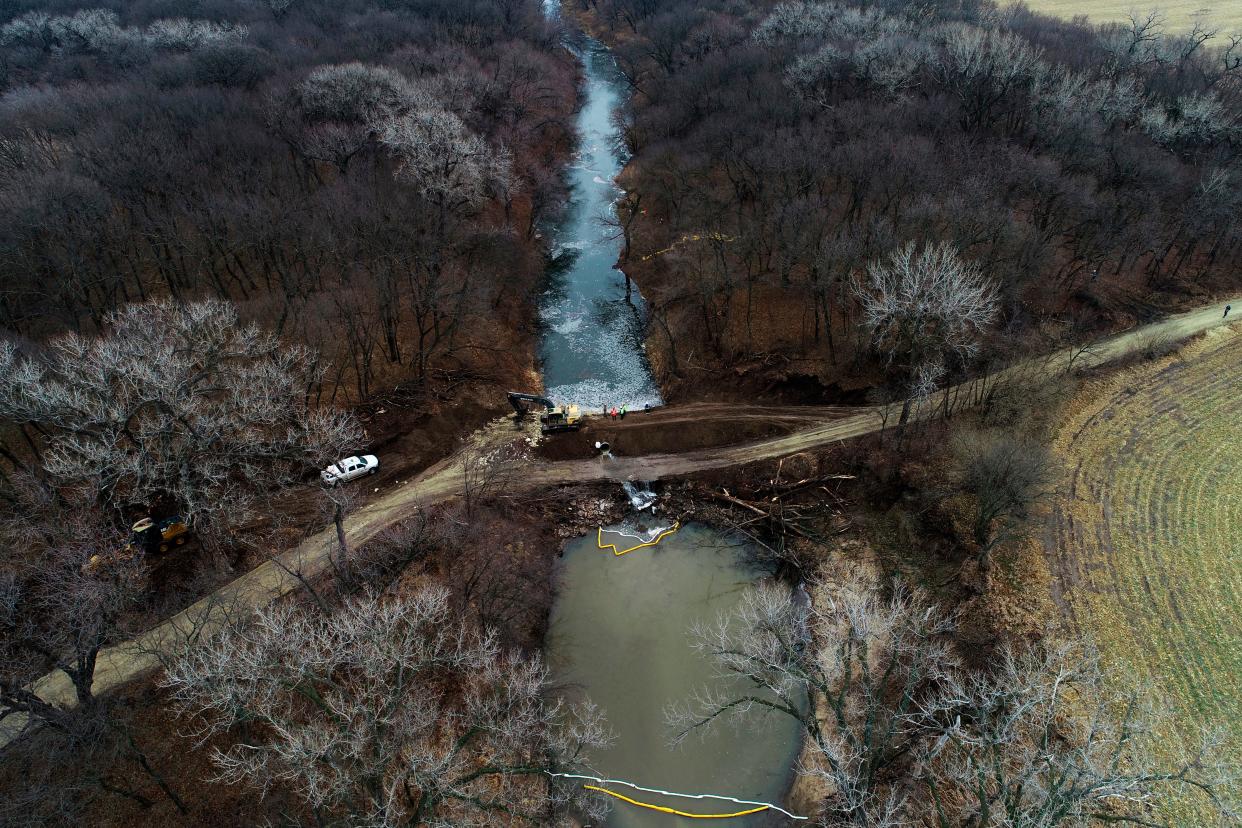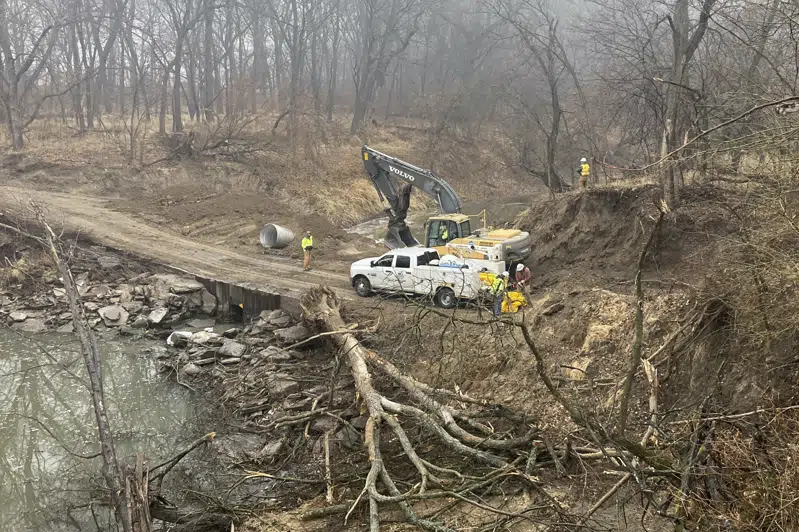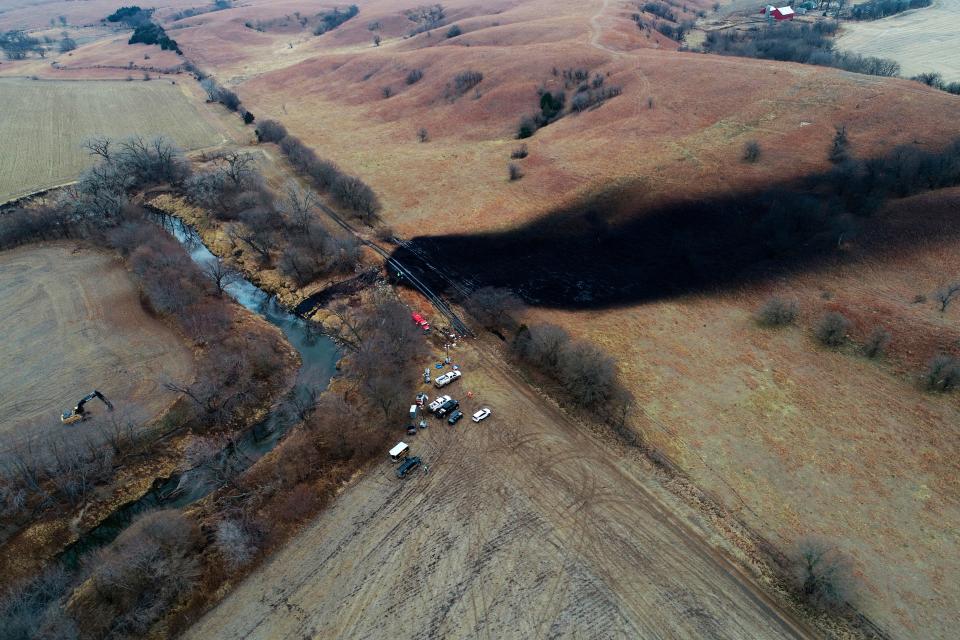As pipeline operator searches for cause of Kansas oil spill, residents await cleanup

The operator of a pipeline system that spilled thousands of barrels of crude oil into a north-central Kansas creek last week has said it is still unclear what caused the incident, the largest in the history of the Keystone pipeline.
The pipeline failure, which occurred in Washington County on Wednesday night, caused over 14,000 barrels of crude oil to flow into Mill Creek, equivalent to over 500,000 gallons or about the size of a water tower.
More:Kansas oil spill biggest in Keystone history, nearly enough to fill Olympic-sized pool
The Environmental Protection Agency said Tuesday it had recovered roughly 2,600 barrels of liquid from the scene, though the bulk of that is an oil-water mixture; only 435 barrels of pure oil have been recovered.
The Pipeline and Hazardous Materials Safety Administration of the U.S. Transportation Department ordered TC Energy — which operates the pipeline over its 2,700 mile run from Alberta, Canada, to Oklahoma — to shut down the 96-mile segment that includes Washington County.
In the USDOT order dated Dec. 8 and signed by Alan Mayberry, an associate administrator for pipeline safety, the agency mandates TC Energy take the segment offline until it takes action to address public health and environmental concerns.
That includes a submitted analysis of what went wrong, testing and a plan for how to restart operations.
Given the unknown nature of what went wrong and those issues which "may have caused the failure remain present in the pipeline and could lead to additional failures," Mayberry wrote that continuing to operate the portion of the pipeline "without corrective measures is or would be hazardous to life, property, or the environment, and that failure to issue this Order expeditiously would result in the likelihood of serious harm."
In a statement released over the weekend, TC Energy said it had a crew of 250 specialists on the scene and that continuous air monitoring was underway. The company said there is presently "no indication of adverse health or public concerns" and the Environmental Protection Agency said Friday that drinking water had not been contaminated as part of the spill.
"We appreciate the patience and collaboration of the surrounding community and partner agencies for their support in responding to this incident," TC Energy said in the statement. "We recognize this is concerning to the community and commit that we will continue our response until we have fully remediated the site."

The EPA noted that TC Energy had constructed a dam four miles from the spill site in a bid to halt the flow of crude oil, with the impact halted beyond the dam. Crews so far have recovered 2,163 barrels of oil-water mixture from from Mill creek and 435 barrels of oil from the ruptured pipeline. Cleanup efforts, however, are expected to last into this week, if not longer.
Randy Hubbard, the county's emergency management coordinator, said the company had presented to county commissioners on the spill Monday and indicated it would be "weeks" until the spill was resolved, but he noted it was unclear whether that would be sooner rather than later.
More:Kansas candidates campaigned as tough on crime. Will that doom criminal justice changes?
The spill is the largest in the history of the Keystone pipeline system and is, in fact, bigger than all other prior spills combined. It is also likely the largest incident of its kind in Kansas history.
The pipeline takes oil drawn from the tar sands of Alberta to Texas to be refined and then distributed for consumption. A separate portion of the pipeline moves oil to a refinery in Illinois.
Kansas residents say they are confident in cleanup effort, future of Keystone pipeline
The spill has brought national attention to a rural slice of north-central Kansas, just miles from the Nebraska border.
Bill Pannbacker, a former state legislator and current farmer and stockman, was one of the landowners affected by the spill, which touched one of his grazing pastures.
More:Kansas Bureau of Investigation director to retire ahead of Kris Kobach administration
Pannbacker said his pasture was not set to be used again until summer, though some of his neighbors had to move cattle from oil-stained land. But he was still expecting it would take years for the land to thoroughly heal and regenerate.
Residents, he said, have long been split over the value in the pipeline running through their county, which was built in 2012. Pannbacker said he was confident in the ability of TC Energy to remediate the area, though he was told to expect clean-up to last through the Christmas and New Year's holidays.
"They have a vested interest in getting that cleaned up," he said, pointing to the millions of dollars worth of oil that flows through the pipeline each day.
Hubbard echoed that sentiment, saying the county was "more than satisfied" with the response from TC Energy and that he didn't expect the spill to sour the working relationship between the company and local governmental officials and residents moving forward.
"This was unfortunate, and obviously, (TC Energy) didn't want it to happen," he said. "We didn't. The landowners, you know, you never want it to happen. But I've heard landowners that are affected say that they still believe that pipeline crude oil transfer is still safer than train, plane, automobile, any of that."
Spill reopens Kansas, national debate over value of oil pipelines

But Zach Pistora, a lobbyist for the Kansas Sierra Club, said the effect on Mill Creek, which runs through much of north-central Kansas and feeds the Blue River that flows into Tuttle Creek Lake, could last far longer than the crowds of workers who are there to clean up the spill.
"I don't know that the creek will ever be the same," he said. "And it's just too bad. Talking with some locals that have grown up in the area and then around the creek and that's their little ecological treasure up there in that area."
The situation has led to differing arguments over what, if any, policy changes on pipelines should come at a federal or state level.
More:Joe Biden taps former Missouri prosecutor to lead U.S. attorney's office in Kansas
In addition to the Pipeline and Hazardous Materials Safety Administration of the U.S. Transportation Department, the Federal Energy Regulatory Commission also regulates interstate pipelines. There is generally, however, little role played by state government in overseeing the industry.
Sen. Mike Thompson, R-Shawnee, chair of the Senate Utilities Committee, said that he was looking at potential hearings to brief lawmakers on the spill and its impact but didn't see a clear role for state government moving forward.
"I don't know that there's much that we should be dabbling with," he said in an interview Monday.
Some have pushed for the federal government to revoke an exemption granted in 2017 that allows TC Energy to run oil through segments of the pipeline at a higher pressure than originally authorized.
There have been three spills since Keystone was granted permission by the PHMSA to operate higher "stress levels" when compared with what is normally allowed. That includes the portion of the pipeline that was affected by the Washington County spill, which also flows through Clay County and part of Nebraska.
That was a surprise to Pannbacker.
"That bothers me," he said. "You know, what's going on here? ... Who gave the clearance to you and you start pushing more products through there with higher pressures? What's the science behind it?"
Under the PHMSA order, TC Energy will be required to cap the oil flow at 80% of the pressure used in the pipeline before the spill.
More:Feds to protect lesser prairie chicken in Kansas. It is likely to touch off a legal battle
Environmental activists have long pushed for a limit to oil and gas infrastructure on public lands. And the proposed extension of the pipeline, dubbed Keystone XL, has long prompted debate and protest. Its approval was halted by President Joe Biden shortly after taking office, despite efforts by former President Donald Trump to allow it to proceed.
Earlier this year, TC Energy paid a roughly $500,000 fine related to a crude oil spill at a delivery facility in Beaumont Texas. The company also received a warning letter in October related to potential safety violations observed by the PHMSA on the Keystone pipeline.
"There's a lot of difficulty and challenge and tragedy with this particular instance," Pistora said. "But, you know, let's remind ourselves, that this is just one sad symptom of the problem with the pipelines and fossil fuel generation to begin with."
Andrew Bahl is a senior statehouse reporter for the Topeka Capital-Journal. He can be reached at abahl@gannett.com or by phone at 443-979-6100.
This article originally appeared on Topeka Capital-Journal: Keystone oil spill in Kansas remains on unclear timeline

